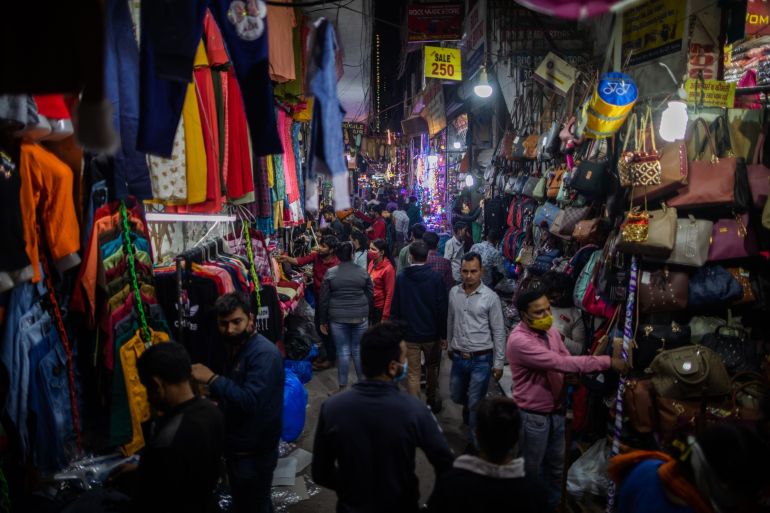India’s economy appears to be stabilising as shoppers return
Business activity, company order books and output prices have rebounded sharply since their coronavirus lockdown lows, Bloomberg data shows.

India’s economic activity showed signs of stabilizing in November, even as concerns of fresh virus outbreaks and a new strain in the U.K. mount amid news of vaccines fueling hope.
All eight high-frequency indicators tracked by Bloomberg News were steady last month, keeping the needle on a dial measuring the so-called ‘Animal Spirits’ unchanged at 5. The level was arrived at by using the three-month weighted average to smooth out volatility in the single-month readings.
Keep reading
list of 4 itemsWhy are thousands of Indian farmers protesting?
India’s governing BJP says ‘no question’ of repealing farm laws
India likely to approve AstraZeneca vaccine by next week: report
The pace of activity thus far was enough for the nation’s central bank to revise its forecast for the economy, which it now expects to exit a recession in the current quarter to December.
![India Animal Spirits economic guage chart [Bloomberg]](/wp-content/uploads/2020/12/366776750.jpg?w=770&resize=770%2C606)
Business Activity
Activity in India’s dominant services sector expanded for a second straight month in November, although at a slower pace. The Markit India Services Purchasing Managers’ Index was at 53.7 last month versus 54.1 in October, with a reading above 50 indicating expansion. IHS Markit, which conducts the survey, said the level of positive sentiment had climbed to the highest since February amid predictions that conditions would normalize once a vaccine is rolled out.
![India business activity, order books, output prices charts [Bloomberg]](/wp-content/uploads/2020/12/366776816.jpg?w=770&resize=770%2C531)
Manufacturing activity lost some of the momentum seen in the past few months, and as a result caused the composite index to drop to 56.3 in November from 58 a month earlier. Both manufacturing and services sectors witnessed broad price pressures, a factor that is likely to keep the inflation-targeting central bank from resuming interest-rate cuts in a hurry.
Exports
Exports lost some momentum last month, declining 8.7% in November from a year ago as trading partners were hit with fresh restrictions amid a second wave of Covid-19 infections. Gems and jewelery and engineering goods exports were a drag, although a deeper fall was arrested by healthier shipments of drugs and pharmaceuticals along with farm products. Imports were weak, with demand for capital goods still subdued and remains a possible cause for worry.
![India goods exports chart [Bloomberg]](/wp-content/uploads/2020/12/366777169.jpg?w=770&resize=770%2C478)
Consumer Activity
Passenger vehicle sales, a key indicator of demand, rose 4.7% in November from a year ago, although the pace was slower than what was seen in the run up to India’s festival of lights — Diwali. Overall retail sales signaled demand picking up, even though they were 44% below the year-ago level, according to ShopperTrak.

Demand for loans picked up from lows seen in October. Central bank data showed credit grew at more than 5.5% in November from a year earlier, higher than the 5.1% growth seen in the second half of the previous month. Liquidity conditions were broadly stable last month.
![India credit demand [Bloomberg]](/wp-content/uploads/2020/12/366777420.jpg?w=770&resize=770%2C513)
Industrial Activity
Industrial production rose 3.6% in October from a year earlier. Production of capital goods, which had declined for several months in a row, rose 3.3% from a year earlier, and so did consumer durables and non-durables.
Output at infrastructure industries shrank 2.5% in October from a year ago. The sector, which makes up 40% of the industrial production index, had contracted by a record 37.9% in April. Both data are published with a one-month lag.